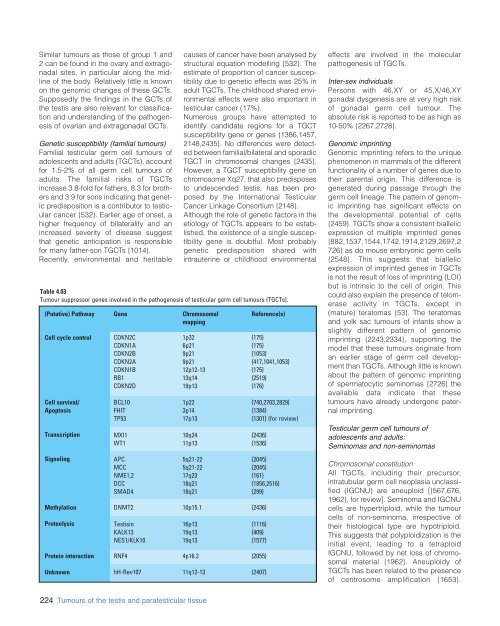CHAPTER X CHAPTER 4 - Cancer et environnement
CHAPTER X CHAPTER 4 - Cancer et environnement
CHAPTER X CHAPTER 4 - Cancer et environnement
You also want an ePaper? Increase the reach of your titles
YUMPU automatically turns print PDFs into web optimized ePapers that Google loves.
Similar tumours as those of group 1 and<br />
2 can be found in the ovary and extragonadal<br />
sites, in particular along the midline<br />
of the body. Relatively little is known<br />
on the genomic changes of these GCTs.<br />
Supposedly the findings in the GCTs of<br />
the testis are also relevant for classification<br />
and understanding of the pathogenesis<br />
of ovarian and extragonadal GCTs.<br />
Gen<strong>et</strong>ic susceptibility (familial tumours)<br />
Familial testicular germ cell tumours of<br />
adolescents and adults (TGCTs), account<br />
for 1.5-2% of all germ cell tumours of<br />
adults. The familial risks of TGCTs<br />
increase 3.8-fold for fathers, 8.3 for brothers<br />
and 3.9 for sons indicating that gen<strong>et</strong>ic<br />
predisposition is a contributor to testicular<br />
cancer {532}. Earlier age of ons<strong>et</strong>, a<br />
higher frequency of bilaterality and an<br />
increased severity of disease suggest<br />
that gen<strong>et</strong>ic anticipation is responsible<br />
for many father-son TGCTs {1014}.<br />
Recently, environmental and heritable<br />
causes of cancer have been analysed by<br />
structural equation modelling {532}. The<br />
estimate of proportion of cancer susceptibility<br />
due to gen<strong>et</strong>ic effects was 25% in<br />
adult TGCTs. The childhood shared environmental<br />
effects were also important in<br />
testicular cancer (17%).<br />
Numerous groups have attempted to<br />
identify candidate regions for a TGCT<br />
susceptibility gene or genes {1386,1457,<br />
2148,2435}. No differences were d<strong>et</strong>ected<br />
b<strong>et</strong>ween familial/bilateral and sporadic<br />
TGCT in chromosomal changes {2435}.<br />
However, a TGCT susceptibility gene on<br />
chromosome Xq27, that also predisposes<br />
to undescended testis, has been proposed<br />
by the International Testicular<br />
<strong>Cancer</strong> Linkage Consortium {2148}.<br />
Although the role of gen<strong>et</strong>ic factors in the<br />
<strong>et</strong>iology of TGCTs appears to be established,<br />
the existence of a single susceptibility<br />
gene is doubtful. Most probably<br />
gen<strong>et</strong>ic predisposition shared with<br />
intrauterine or childhood environmental<br />
Table 4.03<br />
Tumour suppressor genes involved in the pathogenesis of testicular germ cell tumours (TGCTs).<br />
(Putative) Pathway Gene Chromosomal<br />
mapping<br />
Cell cycle control<br />
Cell survival/<br />
Apoptosis<br />
Transcription<br />
Signaling<br />
M<strong>et</strong>hylation<br />
Proteolysis<br />
Protein interaction<br />
Unknown<br />
CDKN2C<br />
CDKN1A<br />
CDKN2B<br />
CDKN2A<br />
CDKN1B<br />
RB1<br />
CDKN2D<br />
BCL10<br />
FHIT<br />
TP53<br />
MXI1<br />
WT1<br />
APC<br />
MCC<br />
NME1,2<br />
DCC<br />
SMAD4<br />
1p32<br />
6p21<br />
9p21<br />
9p21<br />
12p12-13<br />
13q14<br />
19p13<br />
1p22<br />
3p14<br />
17p13<br />
10q24<br />
11p13<br />
5q21-22<br />
5q21-22<br />
17q23<br />
18q21<br />
18q21<br />
RNF4 4p16.2 {2055}<br />
hH-Rev107 11q12-13 {2407}<br />
{175}<br />
{175}<br />
{1053}<br />
{417,1041,1053}<br />
{175}<br />
{2519}<br />
{176}<br />
{740,2703,2829}<br />
{1384}<br />
{1301} (for review)<br />
{2436}<br />
{1536}<br />
{2045}<br />
{2045}<br />
{161}<br />
{1856,2516}<br />
{299}<br />
DNMT2 10p15.1 {2436}<br />
Testisin<br />
KALK13<br />
NES1/KLK10<br />
16p13<br />
19q13<br />
19q13<br />
Reference(s)<br />
{1116}<br />
{409}<br />
{1577}<br />
effects are involved in the molecular<br />
pathogenesis of TGCTs.<br />
Inter-sex individuals<br />
Persons with 46,XY or 45,X/46,XY<br />
gonadal dysgenesis are at very high risk<br />
of gonadal germ cell tumour. The<br />
absolute risk is reported to be as high as<br />
10-50% {2267,2728}.<br />
Genomic imprinting<br />
Genomic imprinting refers to the unique<br />
phenomenon in mammals of the different<br />
functionality of a number of genes due to<br />
their parental origin. This difference is<br />
generated during passage through the<br />
germ cell lineage. The pattern of genomic<br />
imprinting has significant effects on<br />
the developmental potential of cells<br />
{2459}. TGCTs show a consistent biallelic<br />
expression of multiple imprinted genes<br />
{882,1537,1544,1742,1914,2129,2697,2<br />
726} as do mouse embryonic germ cells<br />
{2548}. This suggests that biallelic<br />
expression of imprinted genes in TGCTs<br />
is not the result of loss of imprinting (LOI)<br />
but is intrinsic to the cell of origin. This<br />
could also explain the presence of telomerase<br />
activity in TGCTs, except in<br />
(mature) teratomas {53}. The teratomas<br />
and yolk sac tumours of infants show a<br />
slightly different pattern of genomic<br />
imprinting {2243,2334}, supporting the<br />
model that these tumours originate from<br />
an earlier stage of germ cell development<br />
than TGCTs. Although little is known<br />
about the pattern of genomic imprinting<br />
of spermatocytic seminomas {2726} the<br />
available data indicate that these<br />
tumours have already undergone paternal<br />
imprinting.<br />
Testicular germ cell tumours of<br />
adolescents and adults:<br />
Seminomas and non-seminomas<br />
Chromosomal constitution<br />
All TGCTs, including their precursor,<br />
intratubular germ cell neoplasia unclassified<br />
(IGCNU) are aneuploid [{567,676,<br />
1962}, for review]. Seminoma and IGCNU<br />
cells are hypertriploid, while the tumour<br />
cells of non-seminoma, irrespective of<br />
their histological type are hypotriploid.<br />
This suggests that polyploidization is the<br />
initial event, leading to a t<strong>et</strong>raploid<br />
IGCNU, followed by n<strong>et</strong> loss of chromosomal<br />
material {1962}. Aneuploidy of<br />
TGCTs has been related to the presence<br />
of centrosome amplification {1653}.<br />
224 Tumours of the testis and paratesticular tissue
















